HEL Advocate Brakes
Intended Use: Enduro / DH
Fluid: DOT 5.1
Pistons: 2 x 17 mm + 2 x 15 mm
MSRP: £700 (per pair, including VAT); ~$653 USD at time of publication (w/o VAT)
Stated Weight:
- Lever: 155 g
- Caliper: 105 g
Blister’s Measured Weight:
- Lever: 160 g
- Caliper: 144 g
- Complete Brake (including line, fluid, and pads): 399 g (front) / 429 g (rear)
Bolted to: Contra MC
Reviewer: 6’, 160 lbs / 183 cm, 72.6 kg
Test Locations: Washington & British Columbia
Test Duration: 4 months
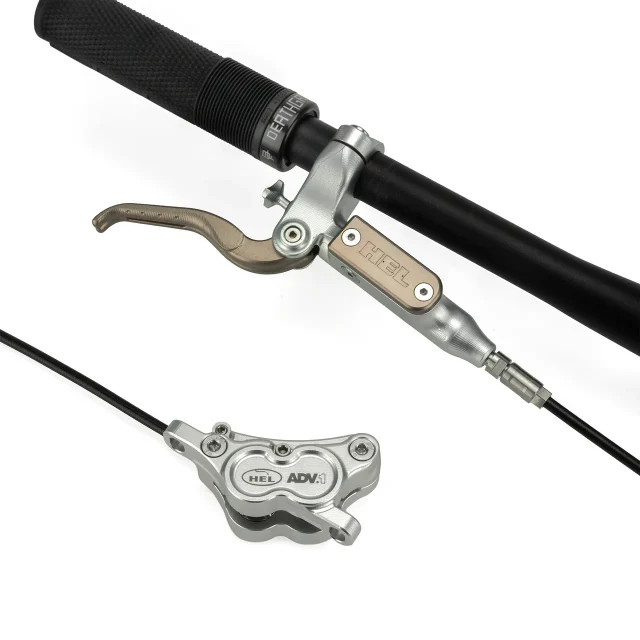
Intro
HEL Performance isn’t a new company by any stretch — they’ve been making hydraulic lines, brakes, and other related parts for motorsports for over 25 years now. However, they’re a newcomer to the mountain bike scene.
They’ve started this new endeavor with the Advocate brake, a four-piston design meant for Enduro and DH use; a two-piston XC / Trail brake is in the works, but we’re going to focus on the Advocate here.
Like their other products, the Advocate is made by HEL (yep, it’s pronounced “hell”) in their own facility in Devon, UK. And, as you might expect from an experienced company dipping its toe into a new market, the Advocate features a mix of relatively conventional design details and a few bits of outside-the-box thinking. Let’s see what they’ve come up with.
Design & Features
The design of the Advocate is straightforward and no-nonsense. The lever assembly is machined from aluminum and uses an asymmetric design with dedicated right- and left-hand levers. The bar clamp uses a rather chunky two-bolt layout, and the industrial-inspired design uses a lot of relatively simple, blocky shapes over more complex organic ones.
That’s true for the master cylinder assembly, at least. The lever blade, on the other hand, gets some very interesting shaping, most notably a groove down the middle of the front face that gives it something of a two-lobed shape. It’s tricky to explain verbally; this is a definite “a picture is worth a thousand words” scenario:
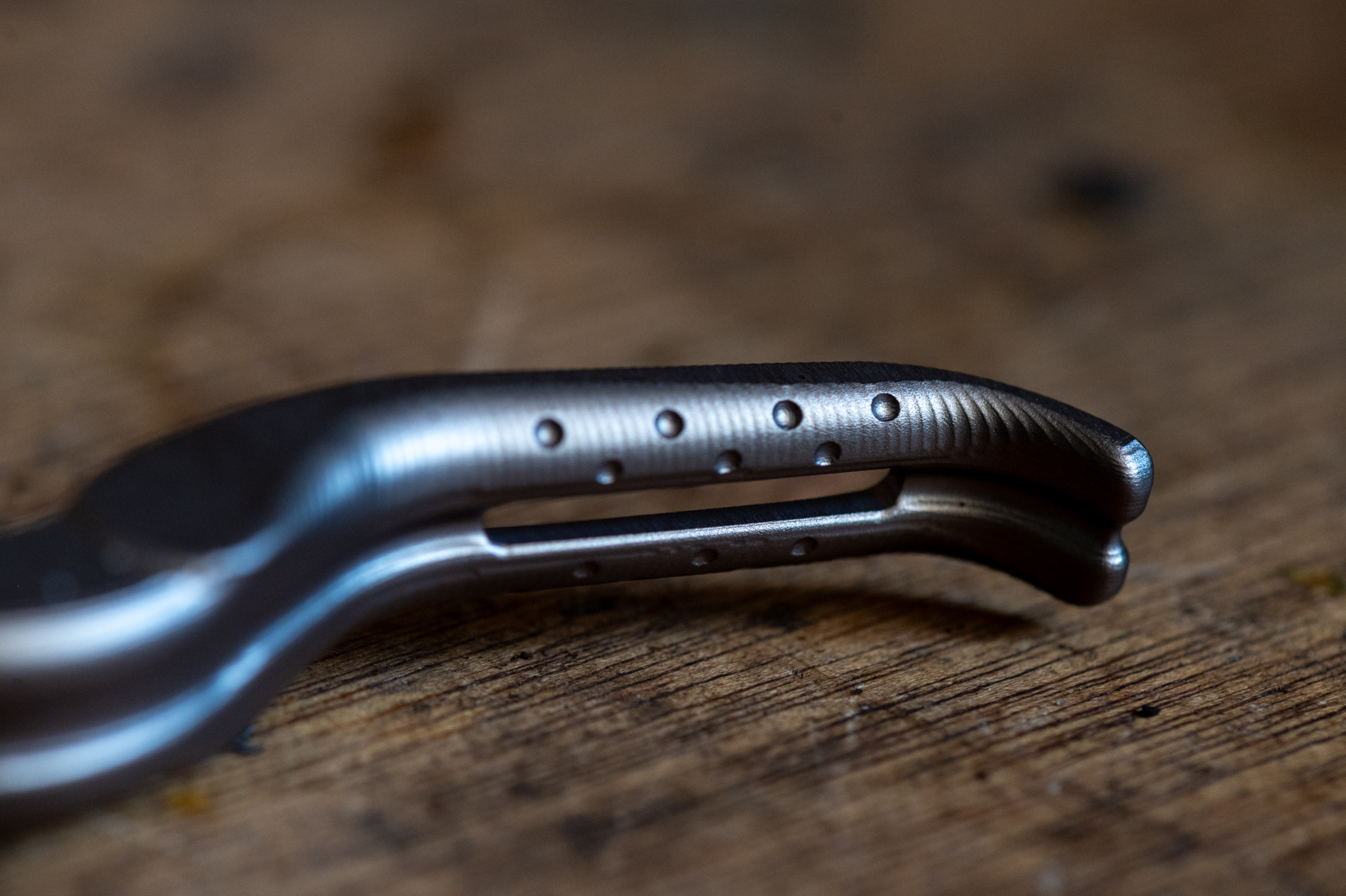
The lever gets a tool-free reach adjuster but not one for adjusting contact point (fine in my book, for reasons I’ve laid out a few times). HEL doesn’t currently have options for integrated clamp mounts either (also fine by me), but those are in the works.
The Advocate’s lever blade is tied directly to the master cylinder pushrod, without any sort of cam to vary the leverage. HEL says that consistency and lever feel were top priorities for the Advocate — and they talk about ‘feel’ and ‘control’ more than they bring up outright ‘power’ — so it’ll be interesting to see how that all comes together on the trail.
The Advocate’s hydraulic leverage ratio isn’t particularly high, which would typically indicate a shorter free stroke and firmer bite point over maximum power. However, the mechanical leverage in the lever assembly plays an equally important role there (and isn’t a spec that most brands publish), so we’ll just have to get the Advocate on the trail to find out.

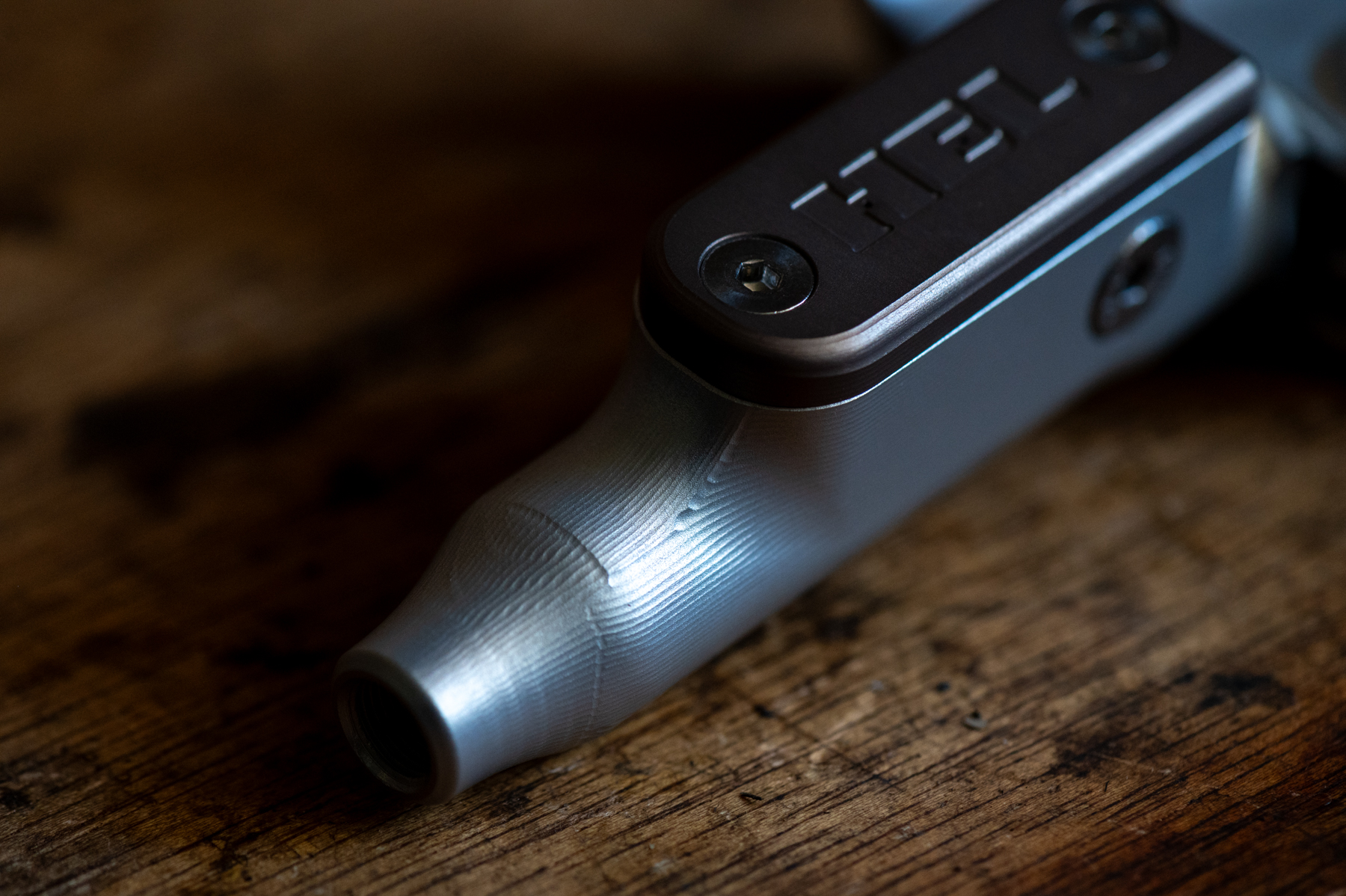
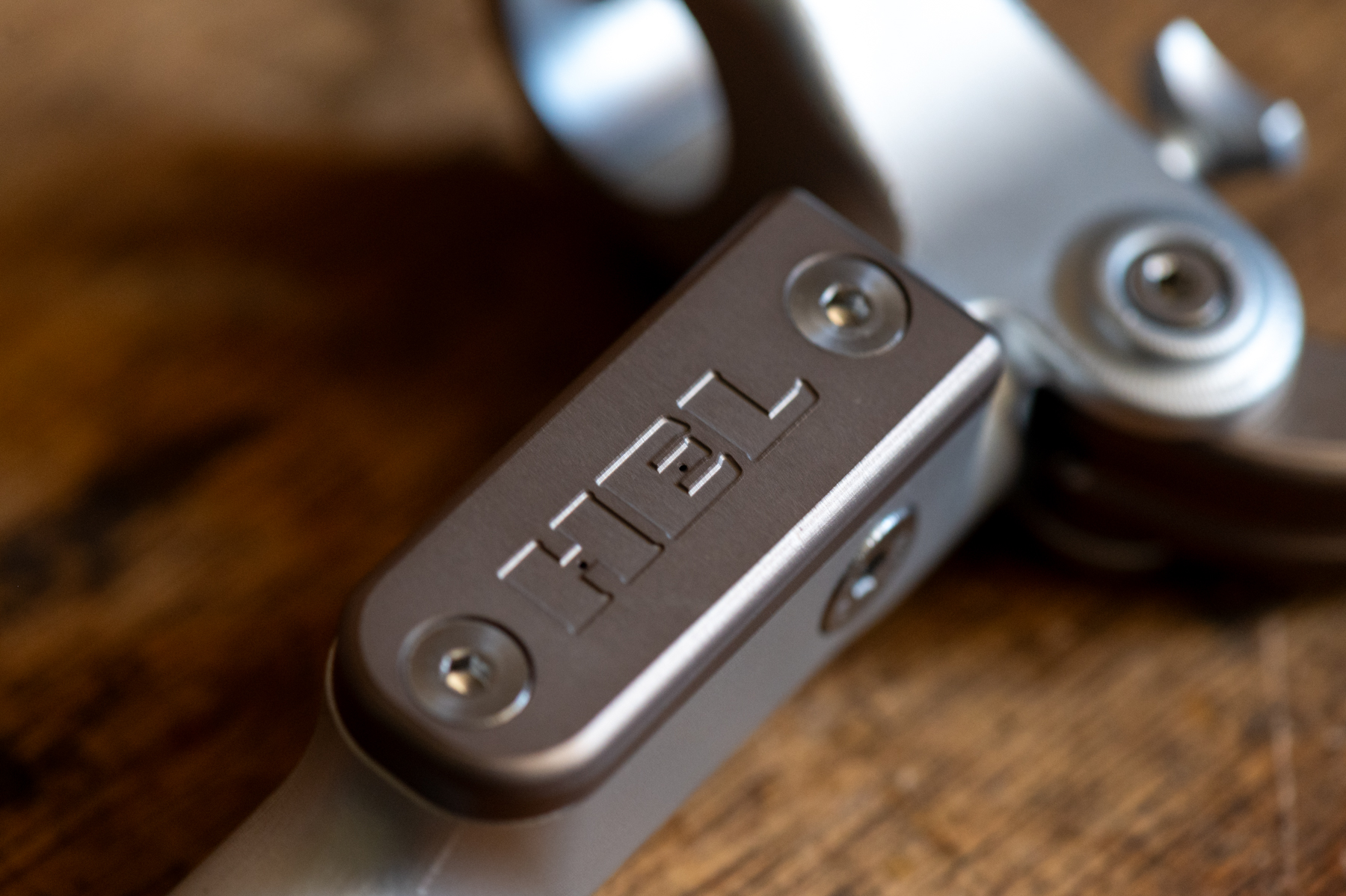
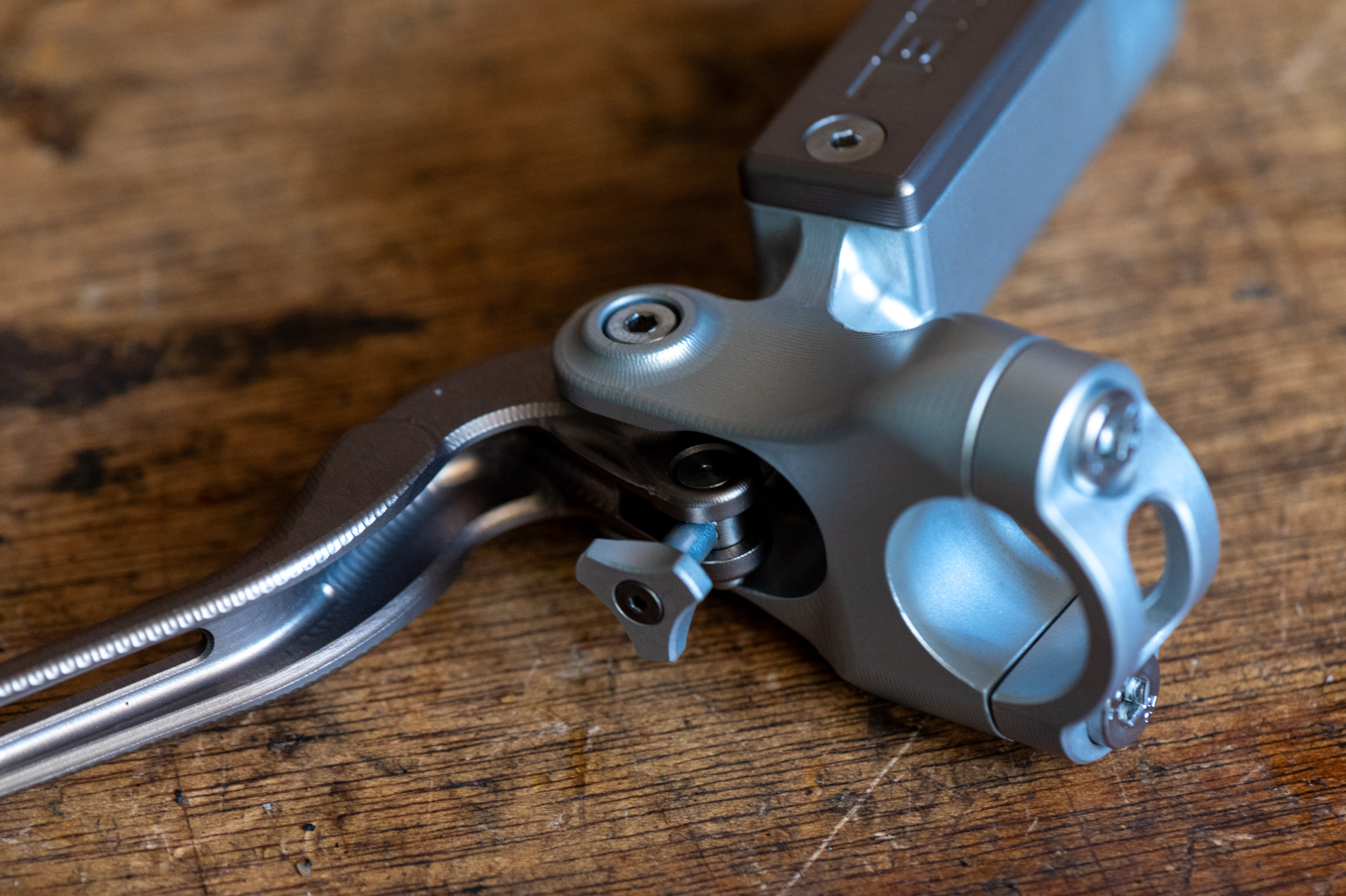
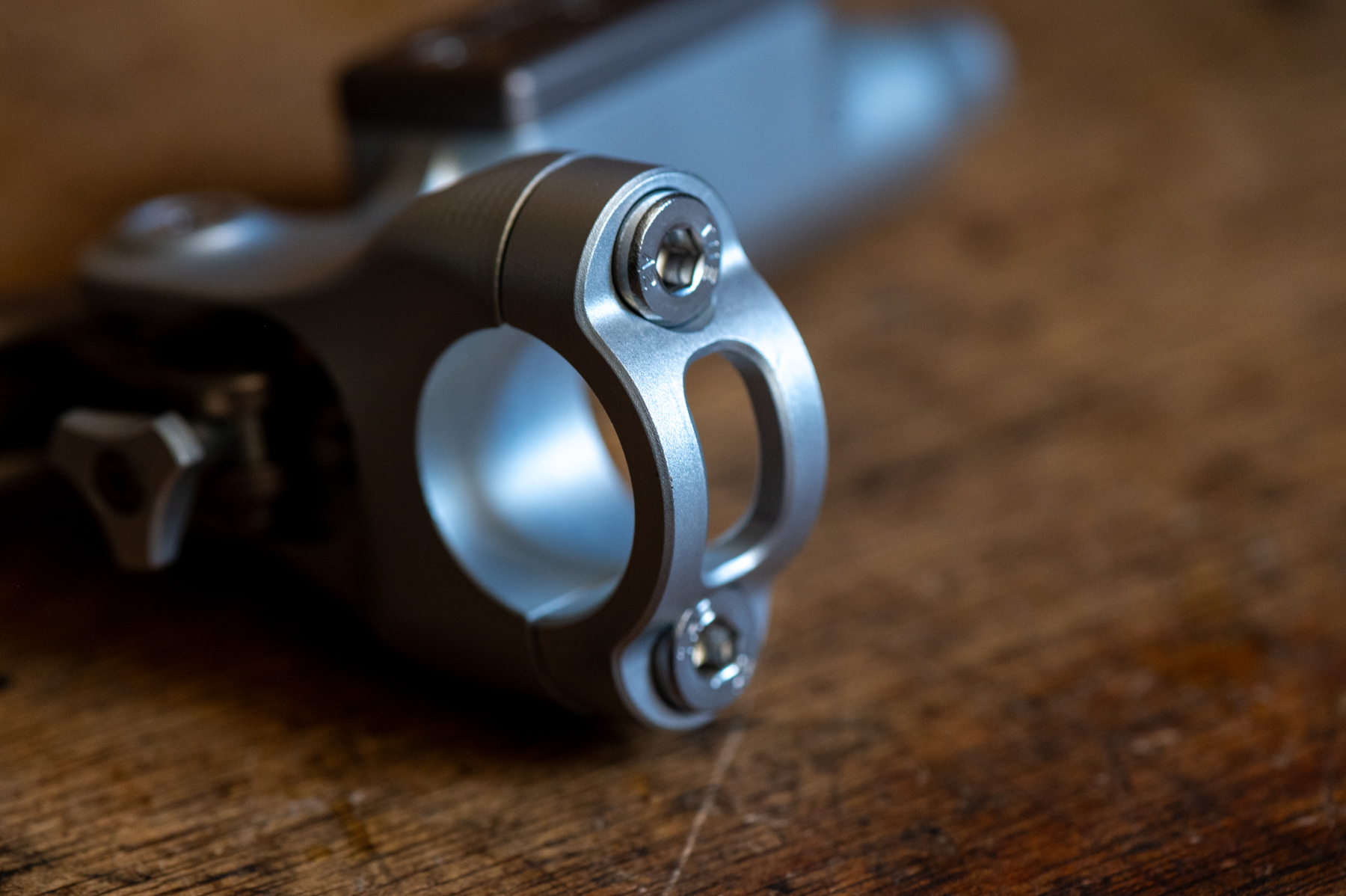
The Advocate’s caliper is also machined from aluminum, and it’s a bolted two-piece design. Both the lever and caliper use 6082 aluminum, which is a bit more corrosion resistant than the more common 6061 grade.
The Advocate caliper features four pistons; two stainless steel 17 mm ones and two 15 mm ones. All of them feature a hollow and castellated design to minimize the amount of contact between the brake-pad backing plate and the pistons, to reduce heat transfer into the fluid. The Advocate uses the same brake pad shape as Shimano and TRP four-piston brakes; the included pads are from Gorilla Brakes.
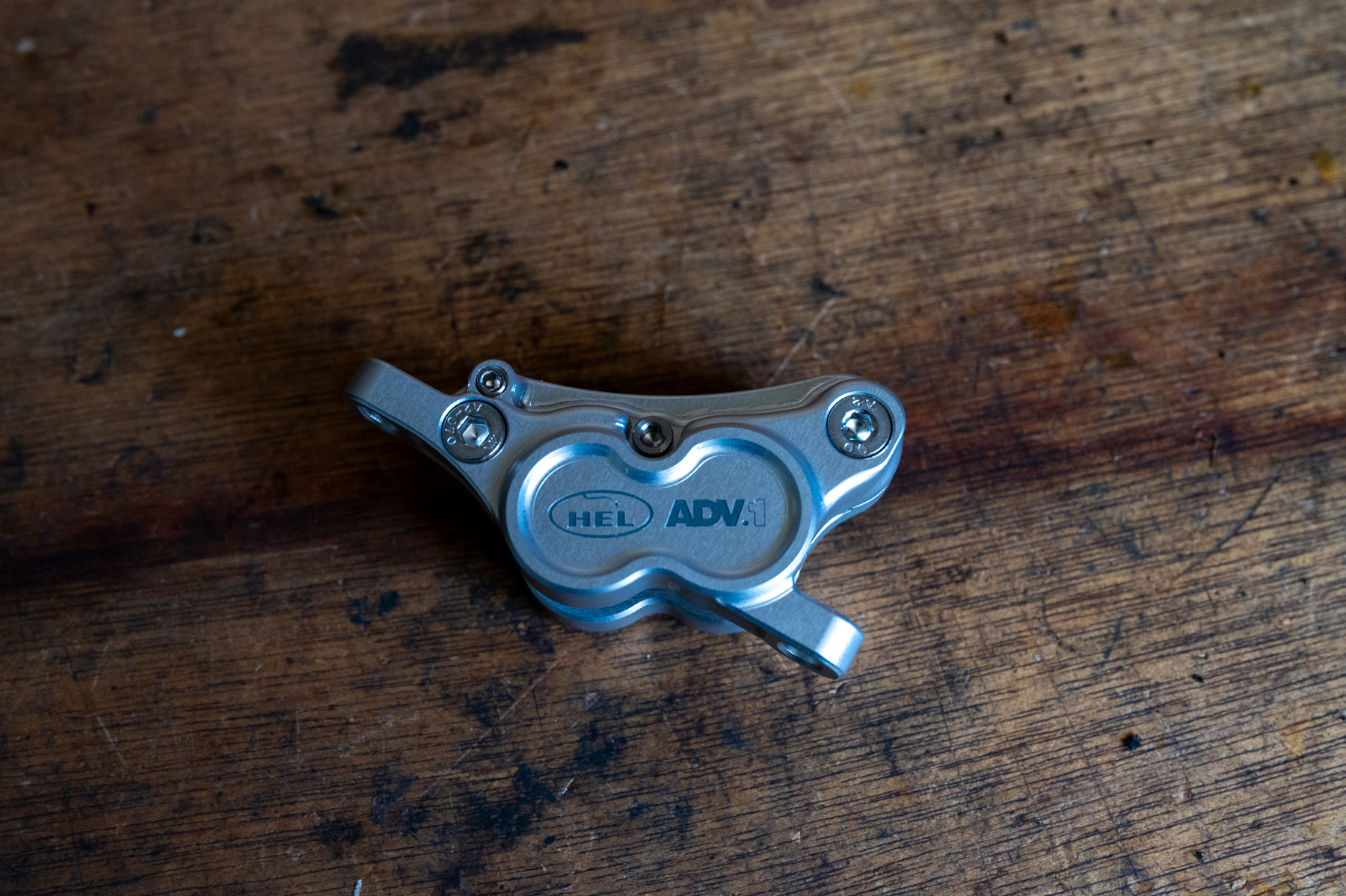

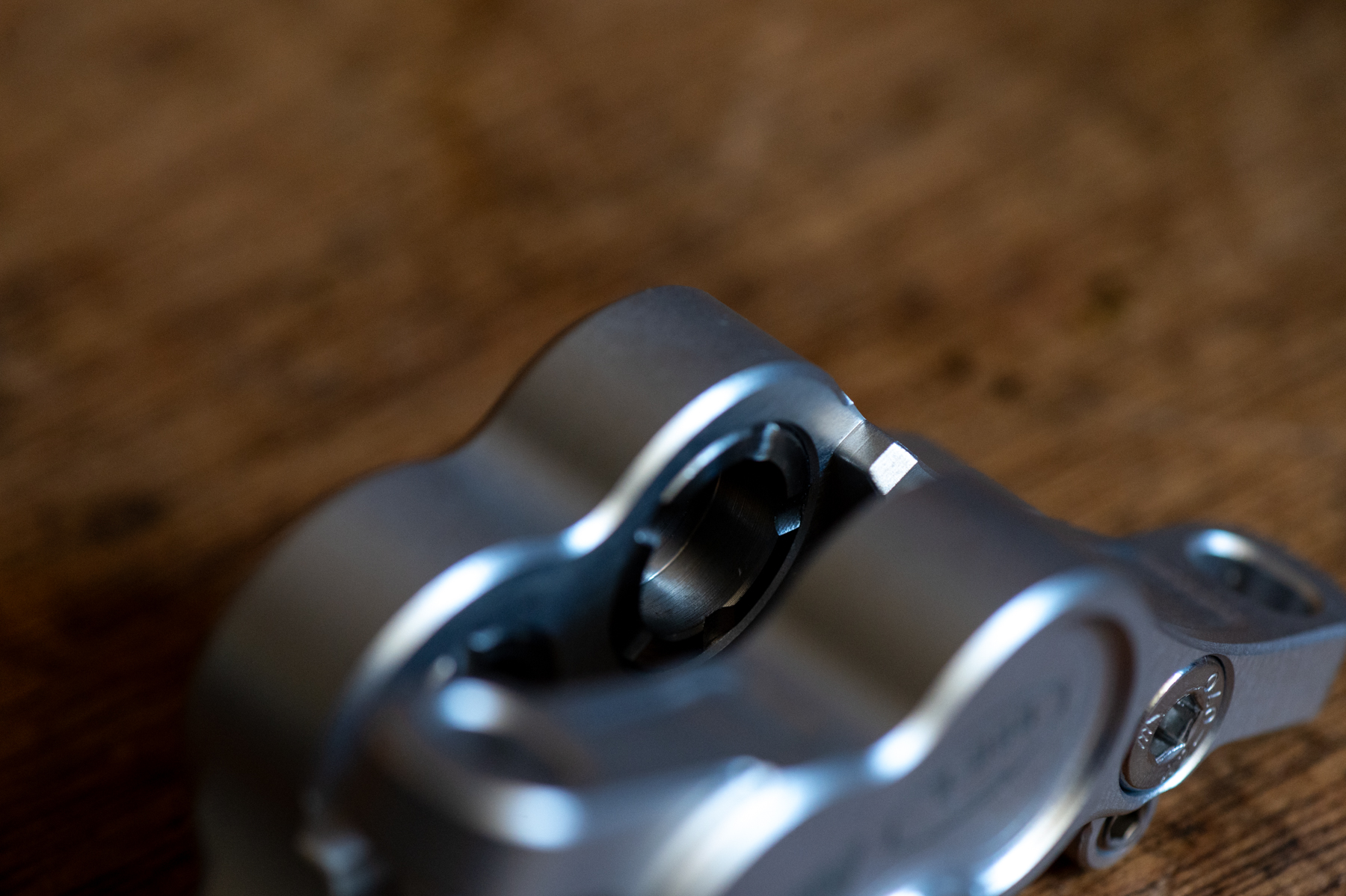
The Advocate brake kit includes a pair of levers, two calipers, a braided stainless steel hose kit, all the required hose fittings, a machined aluminum bleed block, four titanium caliper mounting bolts, and two pairs of brake pads. The hose kit comes as a single 2700 mm piece to cover both the front and rear lines.
HEL currently offers a substantial array of standard color combinations for the Advocate. They will also soon launch a custom brake builder tool that lets you mix and match colors for the various parts of the brake, including the caliper, lever assembly, reservoir cap, lever blade, and bar clamp, with seven different color options for each.
The Advocate brakes come dry and without the lines assembled; doing so is straightforward, and the hose fittings are fully reusable, so you don’t need to track down single-use fittings or cut the hoses each time you take the rear brake on and off a bike with internal routing. The hose has a standard 5 mm outer diameter, in contrast to a lot of other braided hose options, which are often larger and therefore harder to fit inside internally routed frames.
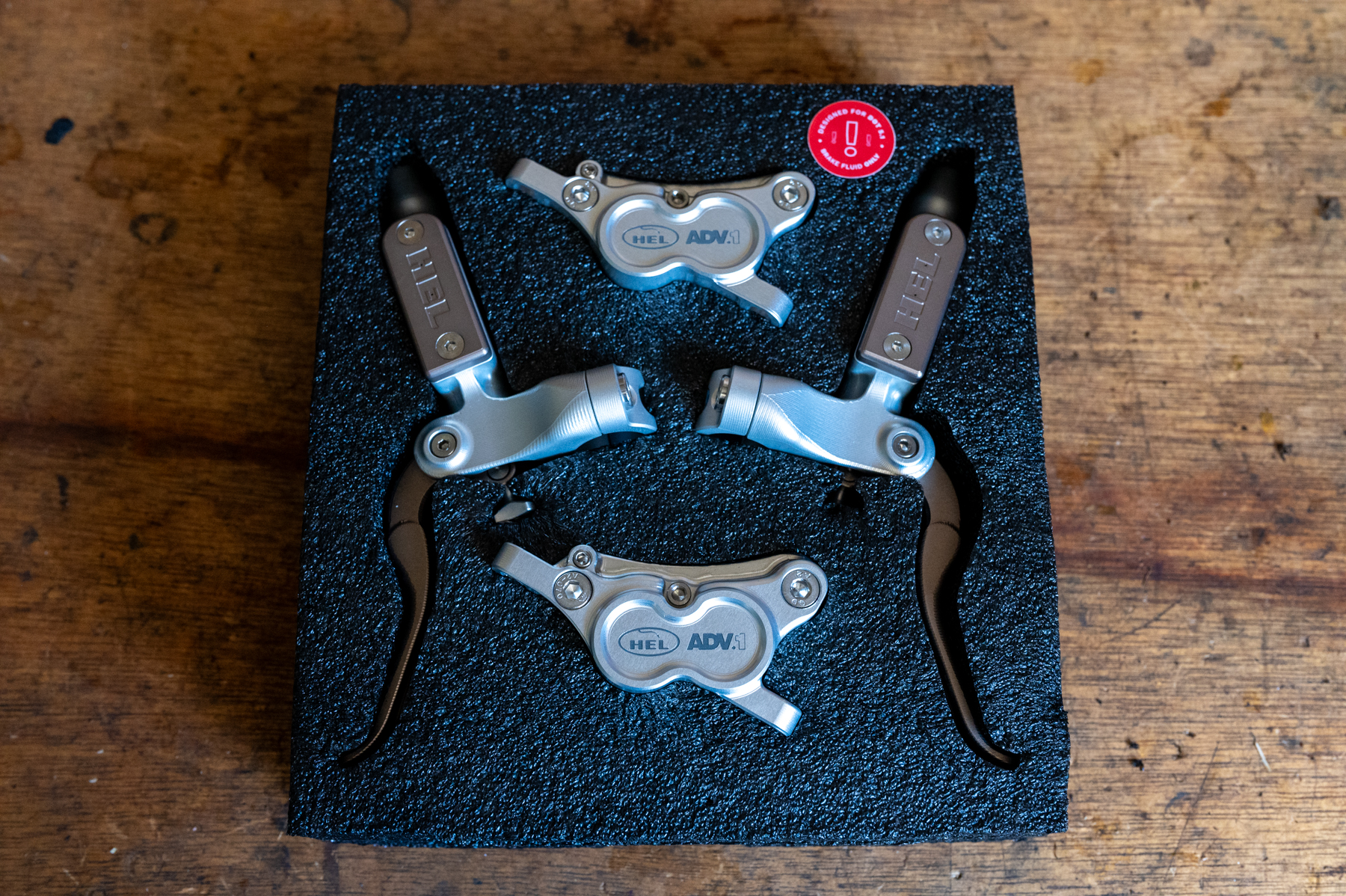
HEL is very clear that the Advocate should be used with DOT 5.1 fluid only; DOT 3, 4, and 5.1 are interchangeable in many systems, but HEL specifically and clearly warns against using anything other than DOT 5.1. The Advocate uses M5 bleed fittings at both the lever and caliper (the same as non-Bleeding-Edge SRAM fittings, Hayes Dominion ones, and others), so common bleed kits can be used.
HEL does a commendable job of offering spare parts for the Advocate, including all the internal seals, replacement caliper pistons, and other small bits. The Advocate is also covered by a one-year warranty, and HEL offers a three-year crash replacement policy for damage that the warranty doesn’t cover. Check out their website for all the details.
Some Questions / Things We’re Curious About
(1) HEL talks a lot about the Advocate offering a very direct lever feel with a firm bite point — so have they pulled it off, and how does it feel on the trail compared to existing alternatives?
(2) What about power? Maximizing power generally brings a longer free stroke and softer bite point — physics demands tradeoffs — so how does the Advocate fare there?
(3) And what is the Advocate like to live with, in terms of reliability, consistency, ease of bleeding, and so on?
FULL REVIEW
Mountain bike brakes have come a long way in recent years, particularly at the gravity-oriented end of the spectrum. Power levels have increased (dramatically, in many cases), reliability has improved overall, ergonomics have been refined, and more.
Against that backdrop, it’s intriguing when a new brand enters the market — particularly one with a long pedigree in motorsports, like HEL. What would they come up with, and how would a fresh take on a gravity MTB brake stack up in an increasingly crowded market?
After four months with their Advocate brake, it’s proven to truly stand out in a few key ways — and will be an especially promising option for the right riders.
But, as always, there are tradeoffs, and the Advocate won’t be the right brake for everyone, either. Let’s dig into it.

On-Trail Performance
The standout feature of the Advocate is its lever feel.
The free stroke of this brake is very short and direct, and then it offers a crisp, firm bite point. HEL’s description of the Advocate focuses substantially on the lever feel, and their characterization is on point. While the Advocate’s free stroke is short, it isn’t especially light; for example, it’s firmer than the free stroke of the Hayes Dominion, Hope GR4, Trickstuff Maxima, and Shimano XT/XTR, but a little lighter than the SRAM Maven.
In terms of outright power, the Advocate is respectable, but far from class-leading. Realistically, that’s something of an inevitable compromise for the kind of lever feel that HEL was going for — and achieved — with the Advocate.
To make a brake ultra-powerful, you need to give it very high leverage. But more leverage means a longer free stroke and softer bite point. The Advocate stands out for offering more power than most brakes with super short free strokes (e.g., Formula Cura 2). Looking at it another way, the Advocate offers a much shorter free stroke than anything I’ve tried that makes even roughly as much power.
To put that power in context, I’d say the Advocate’s power is roughly on par with the SRAM Code RSC (or the Silver / Ultimate Stealth versions). But, in addition to having a much shorter free stroke and appreciably firmer bite point than those Code variants, the Advocate also delivers its power notably differently. The Advocate feels very linear in its power delivery, with a light initial bite that builds smoothly and consistently as you ramp up the lever pressure.

In a lot of situations, that makes the Advocate an especially easy brake to modulate and control. It’s super quick to engage, but doesn’t grab especially hard when you first find the bite point, and instead eases into its power more gradually. There’s solid power available if you really haul on them, but the Advocate’s power delivery doesn’t feel as effortless as the x120 or x220 generation of Shimano’s four-piston brakes, for example (to say nothing of the most powerful brakes out there, like the Hope GR4 and Trickstuff Maxima).
Of course, brake design is a matter of tradeoffs (Ep. 122 of our Bikes & Big Ideas podcast goes deep on that subject). The Advocate won’t be the brake for folks who want the most outright power they can get, but the lever feel the Advocate is able to achieve in trade really stands out.
Brake Pads: Stock vs. Aftermarket
HEL supplies the Advocate with pads from Gorilla Brakes (their Enduro Pro Ultimate compound), which I hadn’t tried before testing the Advocate. These pads offer generally good performance with better durability than a lot of super high-power brake pads (e.g., Galfer Pro or Trickstuff Power+), but these Gorilla pads don’t provide quite as sharp an initial bite as I’d personally prefer.

Happily, the Advocate caliper uses the same pad shape as Shimano’s four-piston brakes (without cooling fins), so a wide array of options is available. Galfer’s Pro pads are my personal go-to in most brakes, and the Advocate is no exception.
In terms of peak power, the Galfer Pros make for a modest bump up over the Gorilla Enduro Pro Ultimates. The bigger change is in how sharply they bite initially — the Galfer Pros are a big step up there. If you’re drawn to the Advocate for its promise of linear power delivery and easy modulation, the stock pads are likely to work well for you; if, like me, you tend to like very powerful brakes with sharp initial power delivery, the Galfer Pro pads help.
Advocate Brake Levers
The Advocate’s funky grooved lever blade is noticeable, but it doesn’t feel as weird as it might look. The hook on the end of the lever isn’t especially pronounced, but the texture on the lever blade (a combination of the groove, some dimples, and subtle machining marks) offers notably good grip. I can tell that there’s a void between the two solid portions of the blade if I’m really thinking about it and paying attention, but I forget about it otherwise.
I tend to run my brakes with the bite point set relatively close to the bar. Paired with my fairly big hands (I wear an XL or XXL glove), this means that I end up wrapping my finger quite far around the brake lever, rather than gripping it near my fingertip.
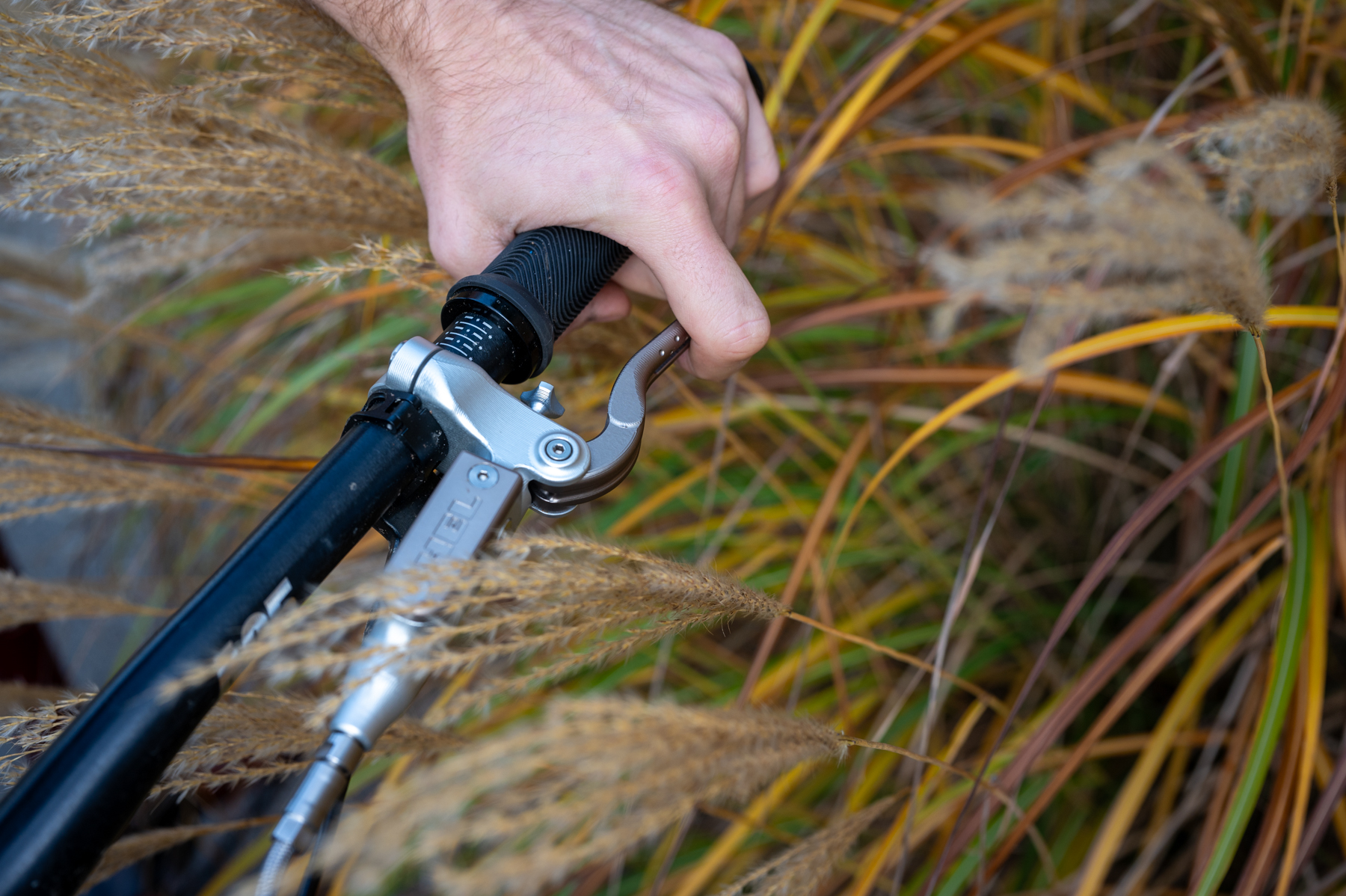
Personally, I think I’d prefer the Advocate lever blade shape if it (1) had a more pronounced hook on the end for better purchase along the length of the lever, and (2) did away with the groove so that there was a bigger surface to distribute pressure over. But I also acknowledge that the way I grip the brake lever is somewhat unconventional, and it’s very easy for me to imagine some folks who grip the lever closer to their fingertips really liking the grooved blade for the added purchase it provides, to stop their finger from slipping off the top of the lever.
The other drawback of the Advocate lever for my combination of close-in bite point + big hands is that, unlike a lot of other brakes, the lever blade is fixed rigidly on the master cylinder pushrod, rather than being able to spring outward from its default resting position.
On most other brakes with that layout (e.g., the Trickstuff Maxima or TRP DH-R Evo), I don’t have any issues, because the free stroke is long enough that the resting lever position leaves plenty of room for my knuckles. But the Advocate’s free stroke is so short that, if I set the reach adjustment so that the bite point lands where I’d ideally want it, my first knuckle hits the lever if I’m not covering the brake lever with my pointer finger, and it doesn’t spring outward to make more room.
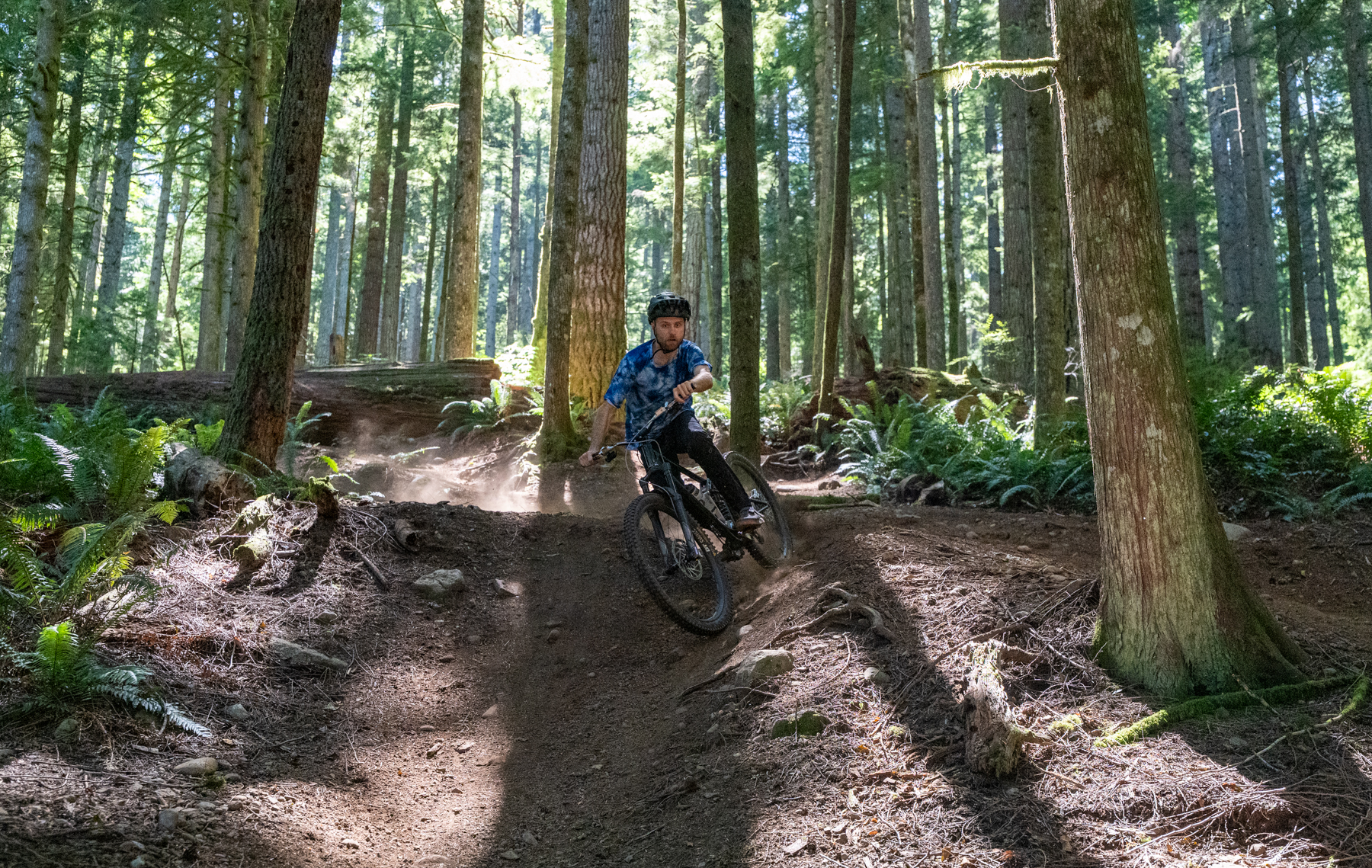
I don’t need to move the reach adjuster very far past where I’d ideally run it to get the clearance I need, and I want to reiterate that my preferences are admittedly a bit unusual here. If any of the following apply to you, I don’t think you’ll have the same issue: (1) you grip the lever blade at your finger tip, rather than wrapping your finger farther around it; (2) you have appreciably smaller hands than my XL / XXL ones; or (3) you don’t run your brake levers notably flat (i.e., with the lever assembly relatively close to horizontal), as I do.
The lever blade in the Advocate also rattles very subtly if you’re climbing without a finger resting on it to stabilize things. It’s nowhere near loud enough to be noticeable if you’re moving at all quickly, but it is a little irritating at granny-gear pace on fire roads.
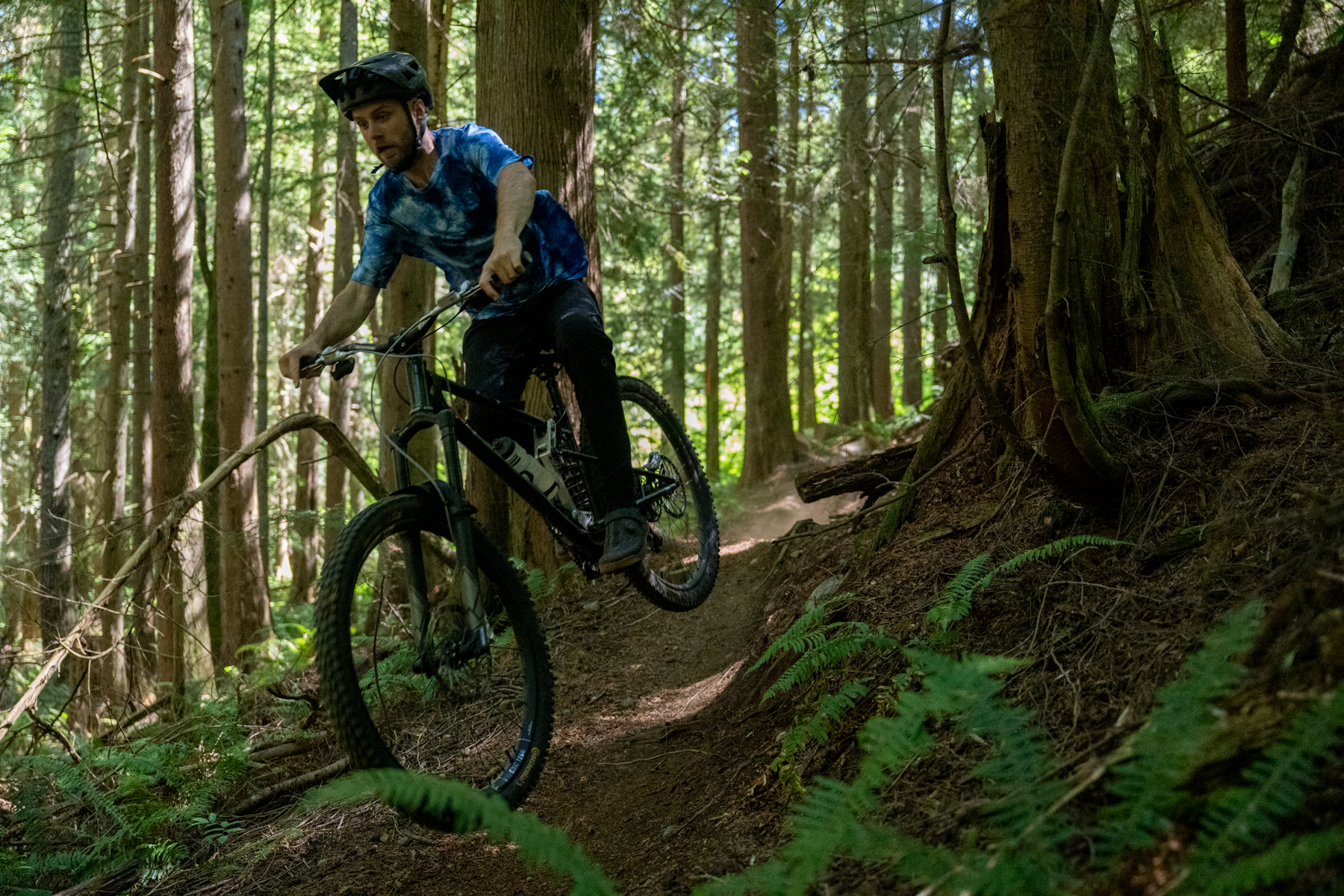
Installation & Servicing / Maintenance
The Advocate brakes come with the calipers and levers disconnected from the hoses and the whole system dry, but getting them installed was still straightforward.
You need to cut the hoses and install the fittings, which are fully reusable (i.e., no single-use olive or barb to replace). Trimming the braided hoses takes good, sharp tube cutters to do so cleanly; straight-bladed side cutters would crush the hose and fray the fine stainless strands, but it’s easy enough with the right tool.
From there, it takes a few cycles of pumping fluid back and forth to fill the system and purge any air bubbles, but I had an easy time getting a solid bleed on the first try. The whole process takes a bit longer than installing most pre-bled brakes, but it was easy enough.
The Advocate uses an adjustable banjo fitting at the caliper end, but it’s limited in how far forward / downward you can rotate it before it hits the caliper body. It’s not a big deal, but I would have been able to get a slightly tidier-looking installation (at least to my eye) with more room to clock the fitting forward.
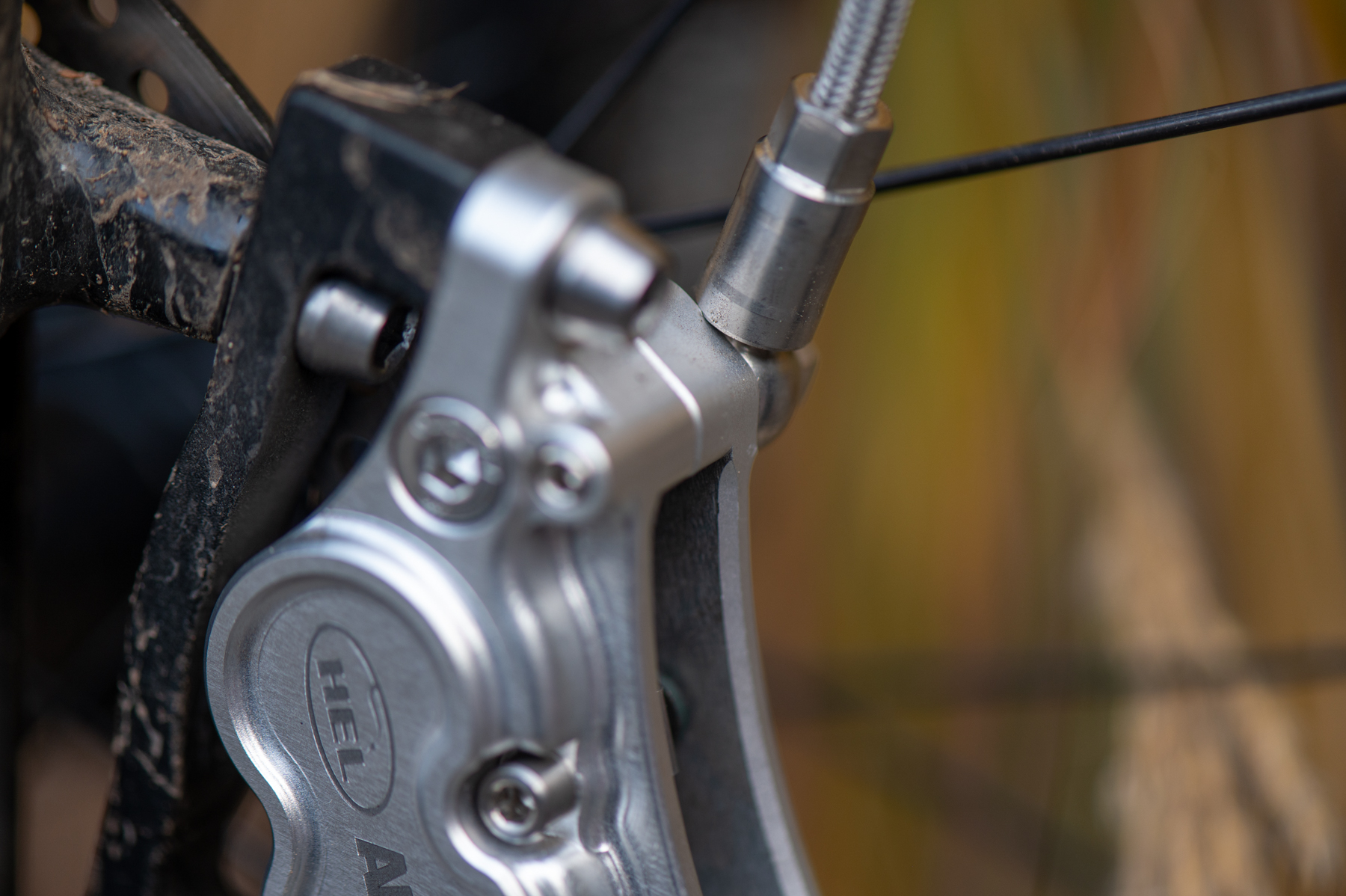
I did, unfortunately, run into an issue with the (first) right-hand lever assembly after a ride or two. I’d squeeze the brake and feel a solid bite point — i.e., not how it’d feel with a poor bleed — but then the lever would go soft and lose line pressure after continuing to squeeze it for a few seconds. It seemed like fluid was bypassing the master cylinder seal, making the initially firm bite point fade away after maintaining pressure for a moment.
HEL said that they’d seen that issue once before on a pre-production brake due to a defective seal, and they sent me a new lever assembly promptly. Over the following months, both the original left-hand lever and the replacement right-hand one worked as expected. All indications are that we just got a right-hand lever with a bad seal, and HEL took care of it.
That foible aside, the Advocate brakes have been very consistent and reliable in their performance. There’s been no noticeable variation in the bite point, they’ve held a bleed well, and they’ve been quiet and fairly easy to keep rub-free.
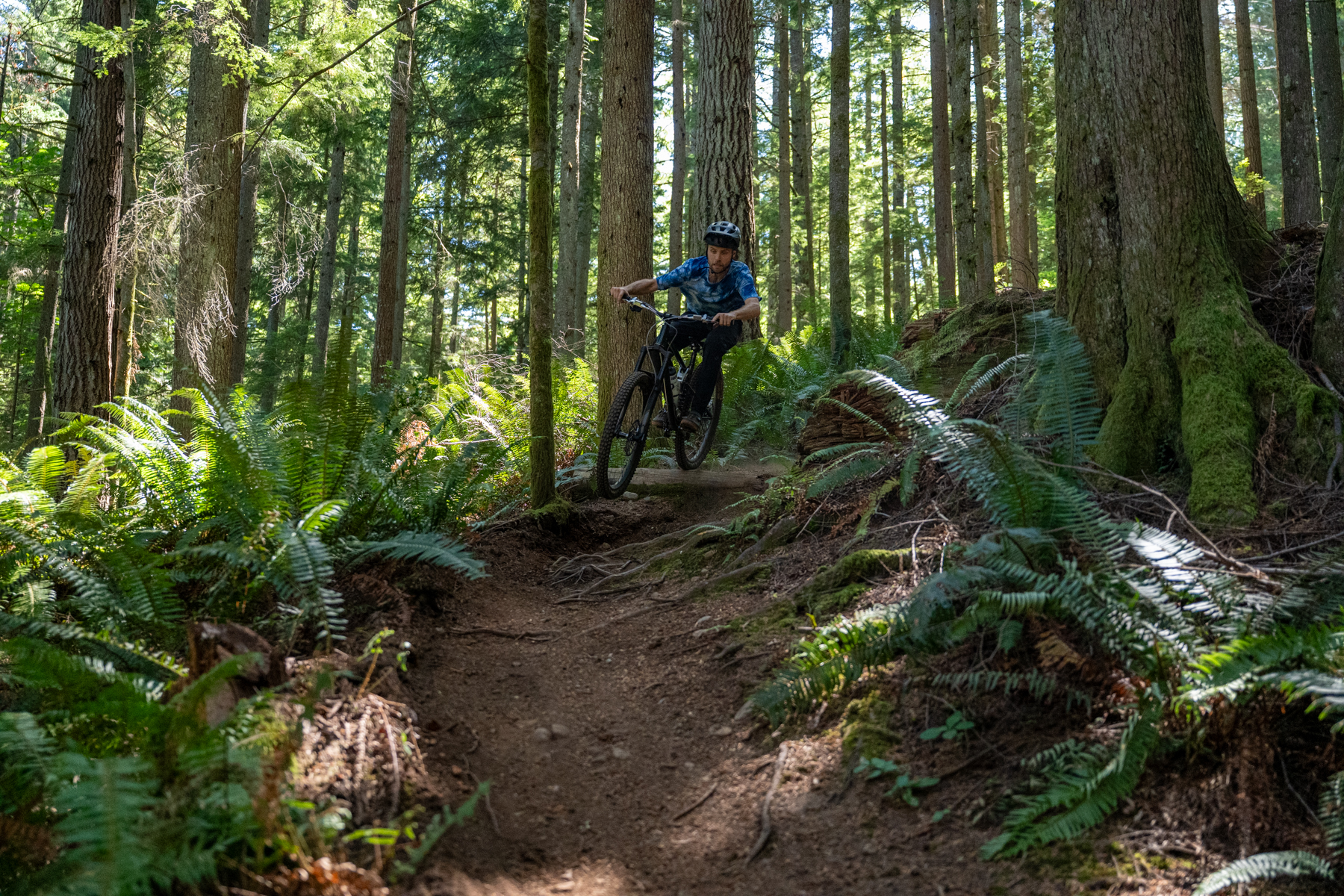
Bottom Line
The HEL Advocate stands out in the current gravity-oriented brake market by offering an exceptionally short free stroke and firm, direct bite point with very linear, predictable power delivery.
The Advocate can’t match the outright power of some of the more stout options on the market, but it’s still powerful enough to be a viable gravity brake for plenty of folks. If you find many of the more powerful brakes on the market to have a longer free stroke than you’d like, or you want something that’s especially easy to modulate while still offering solid power, the Advocate warrants a look.

I’ve had mine since early spring this year. Got the early adopter intro package dealio. Starting with the superficial BS, these are the best looking brakes I’ve ever had. I’ve rocked Magura MT7, SRAM Code (with CC North Fork Calipers) and Maven, Shimano XT & XTR, and Hope Tech4 V4 and can definitely say these beat them in the looks department. It also beats them all in the setup department in terms of simplicity and ease. Their brake line connector and banjo hardware has fewer pieces, is more durable, and definitely reusable. Even though this was the first fully dry set up I’ve done, it was definitely the easiest and required one quick bleed to get off and running. I was able to use my SRAM bleed kit with it too (love the bleed block it comes with).
As far as how they perform, Id say powerfully, smoothly, and predictably. Gobs of power on tap with these things that’s easy to modulate and it always comes on predictably. I do like things like swing link that ramp up power quickly, but with this set up I am always getting the exact power I expect from a pull. Speaking of pulling, the levers on these things are top-notch. I’ve spent way too much money on after market levers before, like Freedom Coast, and can confidently say these are better feeling with more grip. There’s little dead stroke and it gets right to business as you pull. The pull doesnt change after 2k of descent either, as they are some meaty mofo’s, so I would hope that’s the case but yeah, practically 0 brake fade. Lever adjust is nothing unique but super easy and has a pretty wide range of adjustment. A contact adjust point dial might be nice but I’ve never really messed with those much anyways. All this to say, I’ve really REALLY enjoyed them. They just do what they’re supposed to without any gimmicks or fuss and they do it WELL! Did I mention they look killer? So I don’t drag things out I will also just give a quick shoutout to their MTB team as its just a few (3?) dudes starting up that division but they always answered my dumb questions within 12 hours, even though they’re on the other side of the pond. Even managed to ship me them in 4 days.. giving Amazon Prime a run for their money. Awesome, super helpful, and passionate dudes over there.
To be transparent, I did have a small leak coming from one of the lever bodies initially. I could get a ride in but needed to bleed it the next day. When I told them that I thought it was leaking from around the piston and/or rod area, they didn’t even bat an eye. They could have just sent me those pieces but instead they offered to have me send it in and have them completely rebuild it for me with new parts (all free of charge) or just send me a WHOLE NEW lever, also free of charge. Mind you, the last lever body I bought from SRAM was still like $150 for one unit. They then proceeded to send it to me and got it from the UK to UT in 3 DAYS! Holy shit that was rad. Since then the brakes have worked perfectly for months and I love both the brakes and the guys at HEL MTB.